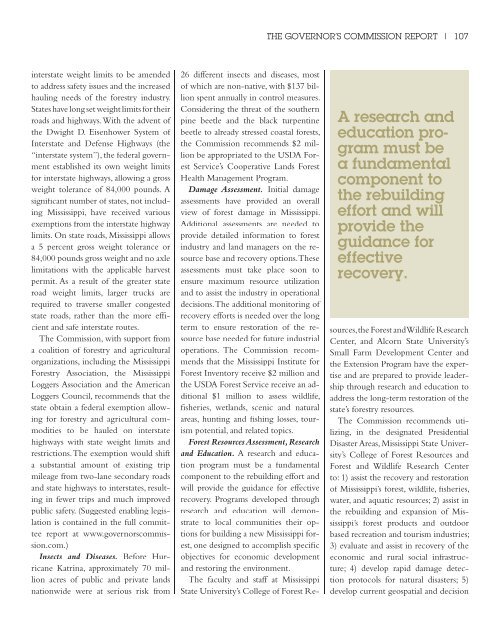Reports - Mississippi Renewal
Reports - Mississippi Renewal
Reports - Mississippi Renewal
- No tags were found...
You also want an ePaper? Increase the reach of your titles
YUMPU automatically turns print PDFs into web optimized ePapers that Google loves.
THE GOVERNOR’S COMMISSION REPORT | 107interstate weight limits to be amendedto address safety issues and the increasedhauling needs of the forestry industry.States have long set weight limits for theirroads and highways. With the advent ofthe Dwight D. Eisenhower System ofInterstate and Defense Highways (the“interstate system”), the federal governmentestablished its own weight limitsfor interstate highways, allowing a grossweight tolerance of 84,000 pounds. Asignificant number of states, not including<strong>Mississippi</strong>, have received variousexemptions from the interstate highwaylimits. On state roads, <strong>Mississippi</strong> allowsa 5 percent gross weight tolerance or84,000 pounds gross weight and no axlelimitations with the applicable harvestpermit. As a result of the greater stateroad weight limits, larger trucks arerequired to traverse smaller congestedstate roads, rather than the more efficientand safe interstate routes.The Commission, with support froma coalition of forestry and agriculturalorganizations, including the <strong>Mississippi</strong>Forestry Association, the <strong>Mississippi</strong>Loggers Association and the AmericanLoggers Council, recommends that thestate obtain a federal exemption allowingfor forestry and agricultural commoditiesto be hauled on interstatehighways with state weight limits andrestrictions. The exemption would shifta substantial amount of existing tripmileage from two-lane secondary roadsand state highways to interstates, resultingin fewer trips and much improvedpublic safety. (Suggested enabling legislationis contained in the full committeereport at www.governorscommission.com.)Insects and Diseases. Before HurricaneKatrina, approximately 70 millionacres of public and private landsnationwide were at serious risk fromA research andeducation programmust bea fundamentalcomponent tothe rebuildingeffort and willprovide theguidance foreffectiverecovery.26 different insects and diseases, mostof which are non-native, with $137 billionspent annually in control measures.Considering the threat of the southernpine beetle and the black turpentinebeetle to already stressed coastal forests,the Commission recommends $2 millionbe appropriated to the USDA ForestService’s Cooperative Lands ForestHealth Management Program.Damage Assessment. Initial damageassessments have provided an overallview of forest damage in <strong>Mississippi</strong>.Additional assessments are needed toprovide detailed information to forestindustry and land managers on the resourcebase and recovery options. Theseassessments must take place soon toensure maximum resource utilizationand to assist the industry in operationaldecisions. The additional monitoring ofrecovery efforts is needed over the longterm to ensure restoration of the resourcebase needed for future industrialoperations. The Commission recommendsthat the <strong>Mississippi</strong> Institute forForest Inventory receive $2 million andthe USDA Forest Service receive an additional$1 million to assess wildlife,fisheries, wetlands, scenic and naturalareas, hunting and fishing losses, tourismpotential, and related topics.Forest Resources Assessment, Researchand Education. A research and educationprogram must be a fundamentalcomponent to the rebuilding effort andwill provide the guidance for effectiverecovery. Programs developed throughresearch and education will demonstrateto local communities their optionsfor building a new <strong>Mississippi</strong> forest,one designed to accomplish specificobjectives for economic developmentand restoring the environment.The faculty and staff at <strong>Mississippi</strong>State University’s College of Forest Resources,the Forest and Wildlife ResearchCenter, and Alcorn State University’sSmall Farm Development Center andthe Extension Program have the expertiseand are prepared to provide leadershipthrough research and education toaddress the long-term restoration of thestate’s forestry resources.The Commission recommends utilizing,in the designated PresidentialDisaster Areas, <strong>Mississippi</strong> State University’sCollege of Forest Resources andForest and Wildlife Research Centerto: 1) assist the recovery and restorationof <strong>Mississippi</strong>’s forest, wildlife, fisheries,water, and aquatic resources; 2) assist inthe rebuilding and expansion of <strong>Mississippi</strong>’sforest products and outdoorbased recreation and tourism industries;3) evaluate and assist in recovery of theeconomic and rural social infrastructure;4) develop rapid damage detectionprotocols for natural disasters; 5)develop current geospatial and decision




